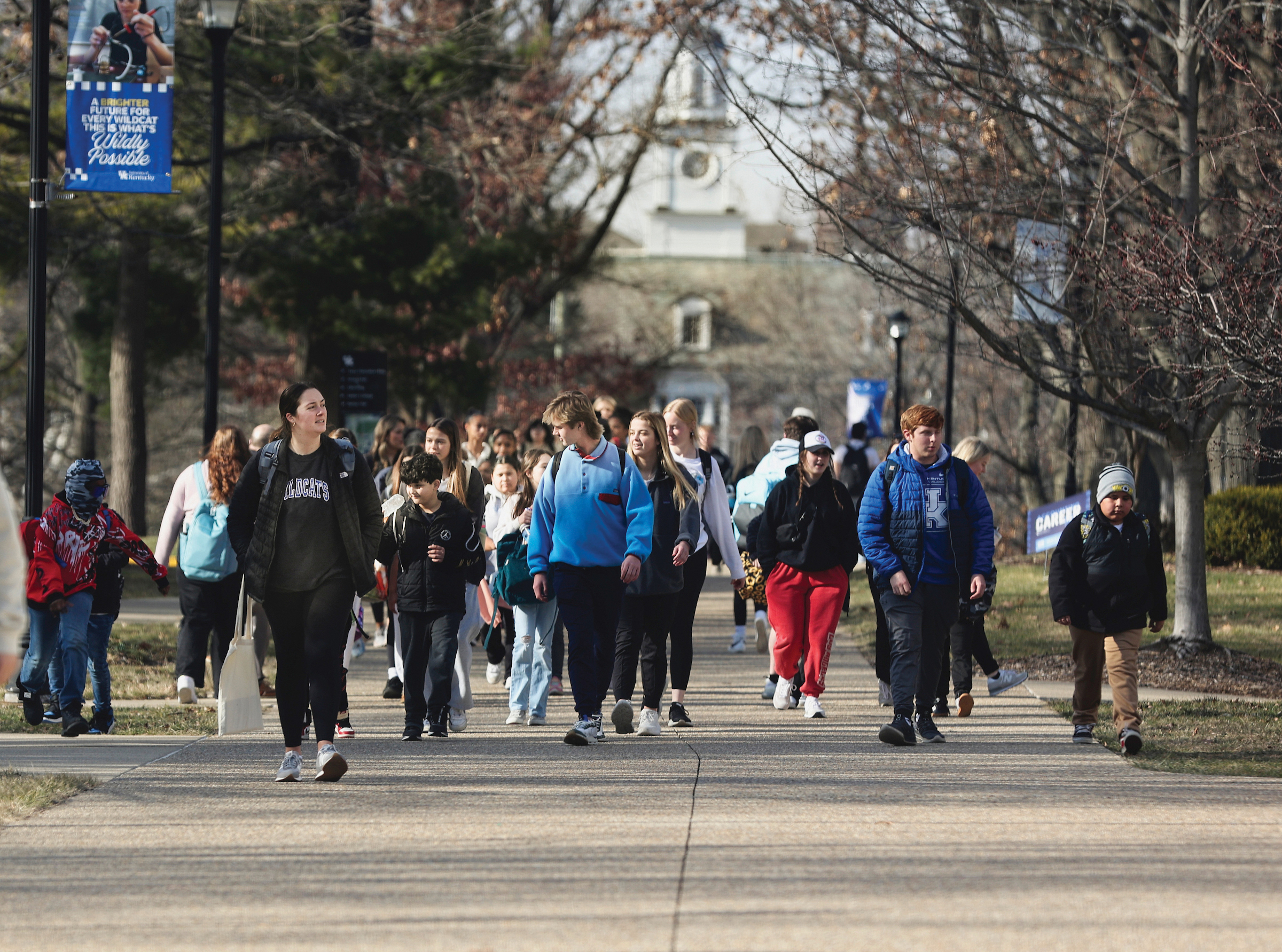
Recently released data from the National Student Clearinghouse (NSC) indicate Kentucky had the highest fall-to-fall total enrollment gains in the nation this past school year.
Between fall 2022 and fall 2023, Kentucky’s colleges experienced 5.6% overall enrollment growth. This compares to a modest 2.1% average rise in colleges across the United States.
A quick look at the growth numbers of a few schools in the commonwealth tells the story of Kentucky’s rise to national prominence. The University of Kentucky is seeing a 21% enrollment growth trend since 2010. Murray State’s 2023-24 freshman class was the largest in history, reflecting a 21% increase. Eastern Kentucky University saw a nearly 30% increase in freshman enrollment.
And while U.S. community colleges have been struggling in the post-COVID climate, the Kentucky Community and Technical College System (KCTCS) is seeing enrollment gains of 7.8%, well above the recent national average of 4.4%.
Like many other Kentucky colleges, the Gordon Ford College of Business at Western Kentucky University is adapting to change and promoting the commonwealth as a top-drawer higher education choice.
“We’ve listened intently to the business community’s needs and expanded our course offerings to include majors and certificates in high-demand fields such as supply chain management, cybersecurity, data analytics, sales and certified financial planning,” Interim Dean Evelyn Thrasher said.
“This sustained growth and success are not just about numbers but the transformative experiences we offer at Western Kentucky University and Gordon Ford College of Business, empowering students to thrive in an ever-changing global landscape,” Thrasher said. “As we continue to evolve and innovate, we remain dedicated to nurturing talent, fostering excellence, creating thought leaders, and shaping the next generations of business professionals.”
Shaping critical thinkers
Asbury University welcomed a near-record number of traditional undergraduate students in the fall 2023 class and is seeing continued growth in online and graduate programs.
“We continually hear from people who are eager for a liberal arts, Christian education that emphasizes academic rigor, mentorship and whole-person development,” said Asbury Director of Strategic Communications Abby Laub. “We also continue to hear from employers that the type of student this setting produces is an ideal fit for their workforce. They need well-rounded, critical thinkers and our alumni move on into impactful careers and professions. We’ve also prioritized the needs of Kentucky’s workforce with programs like pharmacy, nursing and engineering mathematics and these have made a direct impact on our enrollment.”
The University of Kentucky has played a significant role in the recent enrollment growth data trend with overall enrollment growth between fall 2022 and fall 2023 of more than 1,000 students—resulting in a record enrollment of nearly 34,000 students at UK.
This most recent growth is an example of a larger trend at UK over the past decade and a half. Since fall 2010, UK’s overall enrollment has grown by about 21%, from just over 28,000 in fall 2010 to the nearly 34,000 in fall 2023.
“We have seen increases across both graduate and undergraduate students,” said UK Chief Analytics Officer Todd Brann. “For graduate students, the growth has been due in part to an increased number of online programs and enrollment. In the undergraduate space, UK has increased the number of freshman students from Kentucky coming to UK and increasingly become a destination of choice for out-of-state students as well. And perhaps, most importantly, increased retention and graduation rates have helped to drive enrollment, illustrating UK’s commitment to student success. Last year, for the first time in our history, we reached a six-year graduation rate of 70%, a number that places us among the top 100 public institutions (and top 20%) in the country, based on the most recent data.”

Affordability and support create growth
University of the Cumberlands has the third largest enrollment in Kentucky, with a total enrollment for fall 2023 of 20,504, representing a 14% increase in terms of the NSC data study period. Much of this growth can be attributed to Cumberlands’ focus on student success, specifically being transfer-friendly and focusing on retention. According to Leslie Ryser, executive vice president for institutional advancement.
“We focus on putting students first, from the first point of inquiry all the way through graduation,” said Jonathan Shores, Cumberlands’ executive vice president for enrollment management. “We offer quality academic programs that are often innovative and align with the needs of the workforce, especially here in Kentucky, creating greater opportunity for our graduates. And our programs are probably some of the most affordable in the state. Prospective students and families want to know there is value in their investment in education, and we make sure to prove that value exists here at Cumberlands.”
Eastern Kentucky University’s growth has been strategic and intentional, with priorities focused on affordability, support services and its innovative Exceptional Eastern Experience (E3) program. These priorities inspired the creation and expansion of cost-saving programs for students, the addition of new and innovative programs to the university’s repertoire, and a campus environment bustling with student events.
In an effort to remove the financial barriers that stand in the way of higher education, EKU expanded its free textbook program, EKU BookSmart, to include all degree-seeking students. With its data showing the average undergrad spent more than $1,200 annually on textbooks, EKU BookSmart has decreased the total cost of attendance by 9.7% from 2019 to 2024 and saved students a combined $43 million.
In addition to providing free textbooks, EKU awarded more than $38.5 million in scholarships and fellowships last year.
“Education propels individuals toward personal growth, societal progress and the continuous pursuit of knowledge, empowering them to contribute meaningfully to their communities,” EKU President David McFaddin said. “Our commitment is to serve as the ‘School of Opportunity,’ providing an accessible and cost-effective choice for residents of Kentucky and ensuring that the investment in education yields significant returns and long-lasting benefits for our students and the commonwealth.”
Within the past year, Murray State University has been recognized nationally for quality and value by U.S. News and World Report, Forbes and Washington Monthly. This year, Murray State awarded a record $127 million in financial aid and scholarships, with 99% of first-year students receiving financial aid or scholarships.
Both affordability and accessibility continue to be key pillars and priorities for Murray. An impressive 53% of Murray students graduate debt-free, and they lead the state in this metric.
“Our 2023-24 freshman class is the largest in Murray State history and reflected a 21% increase from the previous year—the largest percentage increase among the public universities in Kentucky and our largest overall enrollment since 2017,” said Murray State University President Bob Jackson.
“Despite enrollment headwinds nationally, we continue to experience significant enrollment growth through the hard work of many areas across campus. We have seen record enrollment in specific programs, such as our Statewide Program of Distinction in Cybersecurity and Network Management as well as our Bachelor of Science in Nursing program, which recently admitted its largest cohort ever.”
Strong online learning presence
Adopting the Common Application is among the recent enrollment procedural changes implemented at Western Kentucky University. The Common Application is the most widely used college application across the county. Undergraduates can apply to over 1,000 member colleges and universities in all 50 states.
“We’ve seen a lift in terms of applications submitted to our institution,” said Ethan Logan, WKU’s vice president for enrollment and student experience. “So, we have some really good momentum now, which is expanding our market penetration in terms of where we’re recruiting students.”
“We have to work very hard to get out and meet with students and provide the opportunity to introduce them to Western Kentucky; this is true for all of our schools in the state. Louisville and Kentucky, for example, are well-known institutions, nationally recognized research universities. Some have heard about Western Kentucky because of our history and legacy, but it’s incumbent upon us to reintroduce that to each new generation of students. All of Kentucky’s colleges are collectively working hard ensure that we engage students so that we can continue to cultivate participation.”
Thomas More University in Northern Kentucky has endeavored to “keep it local.”
 “For our 2023 incoming class, we focused on centering local recruitment and enrolling strong students from our backyard here in Kentucky,” says Justin Vogel, dean of enrollment at Thomas More University. “By doing that, we managed to raise our academic profile and increase the number of Kentucky residents in our first-year cohort by over 10%.”
“For our 2023 incoming class, we focused on centering local recruitment and enrolling strong students from our backyard here in Kentucky,” says Justin Vogel, dean of enrollment at Thomas More University. “By doing that, we managed to raise our academic profile and increase the number of Kentucky residents in our first-year cohort by over 10%.”
The Kentucky Community and Technical College System focuses on expanding access and closing opportunity and workforce gaps through a wide range of high-quality academic and technical programs at an affordable cost.
“It was terrific news to see that Kentucky led the nation in enrollment gains this year,” said KCTCS President Ryan Quarles.
“Our investment in a strong online learning presence certainly was a silver lining during the pandemic when we quickly shifted to online learning, and it has continued to grow,” Quarles said. “The noteworthy increases in hybrid options have helped us retain current students and attract new ones. As the largest provider of online learning in the state, KCTCS now has 63% of students taking at least one online class and 36% of students enrolling exclusively online, based on the most recent data.
“This collective achievement is rewarding since it represents very strategic policies and intentional efforts that were literally years in the making by many.”



















